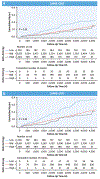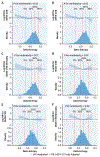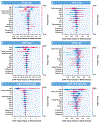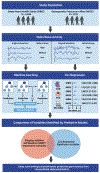Association of Disrupted Delta Wave Activity During Sleep With Long-Term Cardiovascular Disease and Mortality
- PMID: 38573282
- PMCID: PMC12549052
- DOI: 10.1016/j.jacc.2024.02.040
Association of Disrupted Delta Wave Activity During Sleep With Long-Term Cardiovascular Disease and Mortality
Abstract
Background: Delta wave activity is a prominent feature of deep sleep, which is significantly associated with sleep quality.
Objectives: The authors hypothesized that delta wave activity disruption during sleep could predict long-term cardiovascular disease (CVD) and CVD mortality risk.
Methods: The authors used a comprehensive power spectral entropy-based method to assess delta wave activity during sleep based on overnight polysomnograms in 4,058 participants in the SHHS (Sleep Heart Health Study) and 2,193 participants in the MrOS (Osteoporotic Fractures in Men Study) Sleep study.
Results: During 11.0 ± 2.8 years of follow-up in SHHS, 729 participants had incident CVD and 192 participants died due to CVD. During 15.5 ± 4.4 years of follow-up in MrOS, 547 participants had incident CVD, and 391 died due to CVD. In multivariable Cox regression models, lower delta wave entropy during sleep was associated with higher risk of coronary heart disease (SHHS: HR: 1.46; 95% CI: 1.02-2.06; P = 0.03; MrOS: HR: 1.79; 95% CI: 1.17-2.73; P < 0.01), CVD (SHHS: HR: 1.60; 95% CI: 1.21-2.11; P < 0.01; MrOS: HR: 1.43; 95% CI: 1.00-2.05; P = 0.05), and CVD mortality (SHHS: HR: 1.94; 95% CI: 1.18-3.18; P < 0.01; MrOS: HR: 1.66; 95% CI: 1.12-2.47; P = 0.01) after adjusting for covariates. The Shapley Additive Explanations method indicates that low delta wave entropy was more predictive of coronary heart disease, CVD, and CVD mortality risks than conventional sleep parameters.
Conclusions: The results suggest that delta wave activity disruption during sleep may be a useful metric to identify those at increased risk for CVD and CVD mortality.
Keywords: cardiovascular disease; delta wave activity; mortality; spectral entropy.
Copyright © 2024 American College of Cardiology Foundation. Published by Elsevier Inc. All rights reserved.
Conflict of interest statement
Funding Support and Author Disclosures Dr Ai was supported by the National Key R&D Program of China (2021YFC2501500) and the Young Elite Scientists Sponsorship Program by CAST (2021QNRC001). The Sleep Heart Health Study (SHHS) was supported by National Heart, Lung, and Blood Institute cooperative agreements U01HL53916 (University of California-Davis), U01HL53931 (New York University), U01HL53934 (University of Minnesota), U01HL53937 and U01HL64360 (Johns Hopkins University), U01HL53938 (University of Arizona), U01HL53940 (University of Washington), U01HL53941 (Boston University), and U01HL63463 (Case Western Reserve University). The National Sleep Research Resource was supported by the National Heart, Lung, and Blood Institute (NHLBI) (R24 HL114473, 75N92019R002). The Osteoporotic Fractures in Men (MrOS) Study is supported by National Institutes of Health (NIH) funding. The following institutes provide support: the National Institute on Aging, the National Institute of Arthritis and Musculoskeletal and Skin Diseases, the National Center for Advancing Translational Sciences, and the NIH Roadmap for Medical Research under the following grant numbers: U01 AG027810, U01 AG042124, U01 AG042139, U01 AG042140, U01 AG042143, U01 AG042145, U01 AG042168, U01 AR066160, R01 AG066671, and UL1 TR000128. NHLBI provides funding for the MrOS Sleep ancillary study “Outcomes of Sleep Disorders in Older Men” under the following grant numbers: R01 HL071194, R01 HL070848, R01 HL070847, R01 HL070842, R01 HL070841, R01 HL070837, R01 HL070838, and R01 HL070839. Dr Wing has received personal fees from Eisai Co., Ltd for lecture and travel support from Lundbeck HK Limited and Aculys Pharma, Japan, which were not related to the current study. All other authors have reported that they have no relationships relevant to the contents of this paper to disclose. All the individual participants of the SHHS data generated during this study will be made available at the sleepdata.org website. Data from MrOS are available on the MrOS webite. The analysis data set for this specific manuscript is also available from the corresponding author upon request.
Figures






References
-
- Dominguez F, Fuster V, Fernandez-Alvira JM, et al. Association of sleep duration and quality with subclinical atherosclerosis. J Am Coll Cardiol. 2019;73:134–144. - PubMed
-
- Ai S, Zhang J, Zhao G, et al. Causal associations of short and long sleep durations with 12 cardiovascular diseases: linear and nonlinear Mendelian randomization analyses in UK Biobank. Eur Heart J. 2021;42:3349–3357. - PubMed
Publication types
MeSH terms
Grants and funding
- R01 HL071194/HL/NHLBI NIH HHS/United States
- UL1 TR000128/TR/NCATS NIH HHS/United States
- U01 HL064360/HL/NHLBI NIH HHS/United States
- R01 HL070841/HL/NHLBI NIH HHS/United States
- U01 HL053934/HL/NHLBI NIH HHS/United States
- R24 HL114473/HL/NHLBI NIH HHS/United States
- R01 HL070839/HL/NHLBI NIH HHS/United States
- U01 AG027810/AG/NIA NIH HHS/United States
- U01 HL053937/HL/NHLBI NIH HHS/United States
- U01 AG042139/AG/NIA NIH HHS/United States
- R01 HL070848/HL/NHLBI NIH HHS/United States
- U01 HL053916/HL/NHLBI NIH HHS/United States
- U01 HL063463/HL/NHLBI NIH HHS/United States
- R01 HL070847/HL/NHLBI NIH HHS/United States
- R01 HL070842/HL/NHLBI NIH HHS/United States
- R01 AG066671/AG/NIA NIH HHS/United States
- U01 AG042124/AG/NIA NIH HHS/United States
- U01 AG042145/AG/NIA NIH HHS/United States
- U01 HL053938/HL/NHLBI NIH HHS/United States
- U01 HL053941/HL/NHLBI NIH HHS/United States
- U01 AG042168/AG/NIA NIH HHS/United States
- U01 AG042140/AG/NIA NIH HHS/United States
- R01 HL070838/HL/NHLBI NIH HHS/United States
- R01 HL070837/HL/NHLBI NIH HHS/United States
- U01 AG042143/AG/NIA NIH HHS/United States
- U01 AR066160/AR/NIAMS NIH HHS/United States
- U01 HL053931/HL/NHLBI NIH HHS/United States
LinkOut - more resources
Full Text Sources

